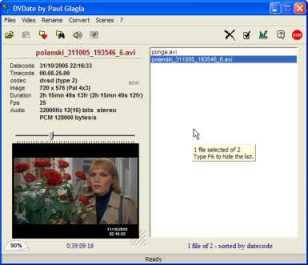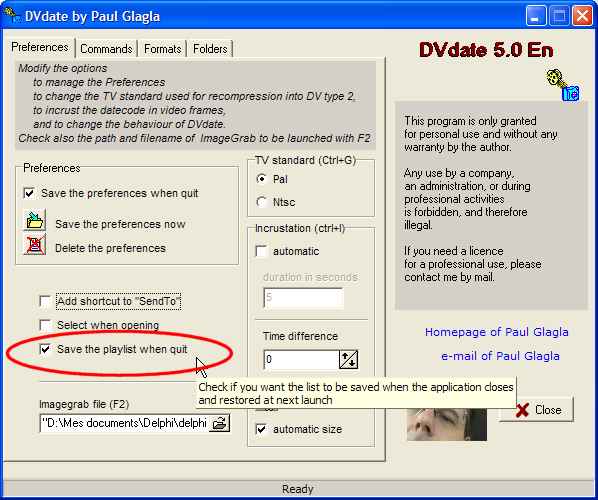
How to use the Playlist of DVdate
to have a selection of avi files at hand and sort them according to your needs
Help pages about DVdate:
This page is better viewed in 1024x768.
Last update on
Monday, December 11, 2006

- How to use the playlist of DVdate
- adding files to the playlist
- remove files from the playlist
- show or hide the playlist
- sort the playlist
- save and open the playlist
- use the default playlist
- How to select files in the playlist of DVdate
- toggle between wide and narrow display with F6
- play the video with Space
- modify the volume level with + or - from numeric keypad
How to use the playlist of DVdate
When DVdate is launched (look here), and at least two AVI files are loaded in it, then the list of all files loaded in DVdate is displayed on the right of the main window. It is the playlist of DVdate. It is convenient to have many files at hand to better process or analyze them.
![]() Adding files to the playlist
Adding files to the playlist
You may always add files to the playlist exactly in the same way as for opening files on the empty window (see how to open files). You may for instance add files to the list by opening them by name, or by opening complete folders, or pasting them from the clipboard, by dragging them from a Windows program, or by opening a text file from a previously saved playlist.
![]() Remove files from the playlist
Remove files from the playlist
To remove files from the playlist, select them and type Del on the keyboard. The files remain unchanged on the hard disk. They are only removed from the playlist. The same result is obtained with the Menu Video /Remove the file.
To remove all files and empty
the list, type CTRL+Del or
click on the button Empty
the list ![]() .
.
![]() Show or Hide the playlist
Show or Hide the playlist
To show or hide the playlist, type F6 or the menu Files/Show the list or Files/Hide the list. You may thus display the playlist even if it contains only one file, or hide it even if it contains many files.
![]() Sort the playlist
Sort the playlist
You may sort the playlist by alphabetical order (ALT+A), or by datecodes (ALT+D), or file size (ALT+S) or by date of last modification of the file (ALT+F). The corresponding commands are also available in the Menu Files/Sort the list or in the popup menu opened by a right mouse click on the list. You may notice under the playlist, the sort mode is displayed as well as the number of files selected among the total number of files.

![]() Save and Open the playlist
Save and Open the playlist
You may save the playlist to your hard disk and reopen it later. To save the file, type CTRL+J or the menu command Files/Save the playlist as... This saves the playlist to a text file, that you may modify with notepad or any text editor. This file is compatible with the m3u format for playlists, ie each filename is written, with its path, on one line. The text file may also contain comments starting with #. Any way, if DVdate considers that a line does not represent an AVI file, it ignores the line.
You may open all AVI files contained in a saved playlist with CTRL+U or the menu Files/Open the playlist...
![]() Use the default playlist
Use the default playlist
DVdate considers a particular playlist as the default playlist. It's a text file called playlist.txt located in the default folder for playlists (See here how to change the default folders). This playlist is quick to open, with Shift+F7 or with the Menu Files/Open the default playlist.
The default playlist plays a special role. In the Preferences of DVdate, you may choose to save the playlist each time the application closes, by checking the box Save the playlist when quit. The list of all open AVI files will then be saved in the default playlist when you quit the DVdate. At next start of DVdate, it will then automatically be loaded.

In the playlist of DVdate, the selected files are highlighted with blue (or your default highlight color). At first only one file is selected. Each time you click on a filename in the playlist, you select this file and only this one. You may also select the next or previous file in the list with the arrow keys Up or Down. At each change in the list, the information displayed at the upper left and the video displayed at the bottom left change simultaneously to reflect the data corresponding to the selected file. The menus change also with the change of selection, and contain only the commands available for the selected file. For instance if you select a DV file of type 1, you will find in the menu Convert a command Convert to DV type 2, but no command Convert to DV type 1. Of course, when you click on a menu command it is applied to the selected file.
If you want to apply a command to several files, you must first select the set of files in the playlist. To select several files one by one, click on each file while holding the key CTRL down.
To select a continuous series of files, click on the first, then holding the key Shift down, click on the last one, or move the selection with the arrow keys while holding the Shift key down. The last selected file will display its data on the left (information and video). It is underlined by a very light rectangle.

To select all
files in the playlist, type CTRL+A or
click on the button Select
All ![]() .
.
Notice that browsing through the playlist with Up and Down key is very secure. Even if the playlist is not visible, or when you have a full screen display, you may browse from one file to the next or previous with a single hit on the arrow key.
Finally, you may appreciate an option in the Preferences panel of DVdate: it forces all newly loaded files to be automatically selected after the opening. This is set in the Settings panel (F10) under the tab Preferences where you may check or uncheck the box Select when opening.
How
to install and launch
DVdate ![]()
![]() How to get Informations about an
avi
file
How to get Informations about an
avi
file
















